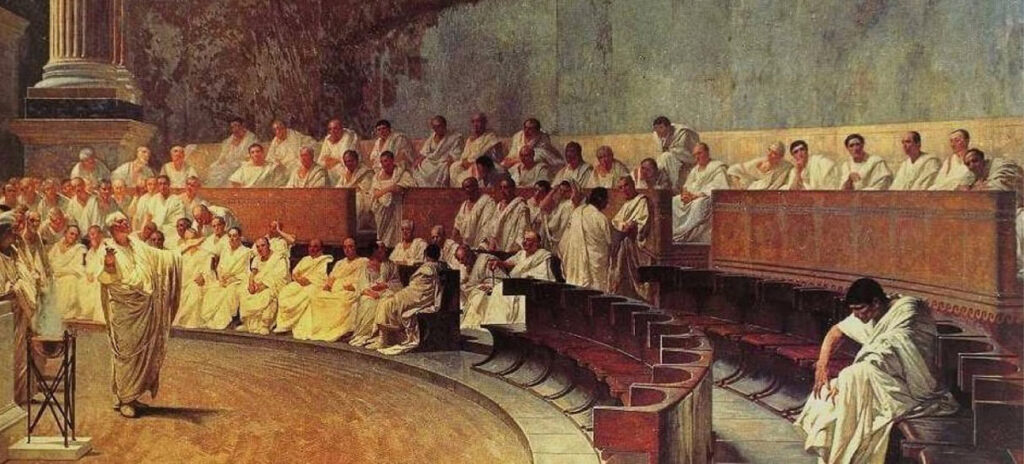“Lorem ipsum,” as you probably know, is placeholder text that allows clients to focus on design and UX, without getting distracted by the content — i.e., the words. Makes sense, right?
We’re not so sure. But first, let’s ask a more fundamental question: what is lorem ipsum?
A Brief History of Lorem Ipsum
The most commonly used lorem ipsum text (as quoted in the intro) is derived from a treatise called The Extremes of Good and Evil, written in Latin by the Roman statesman Cicero in 45 B.C. When the use of printing presses spread in the 1500s, it was selected by an unknown printer as default text for the laborious task of typesetting. Somehow, this unremarkable string of Latin characters survived as an industry standard as printing evolved from the manual to electronic press, to desktop publishing, and cloud-based printing.
Got it? The copy on your in-progress website was written by a Roman orator, more than 2000 years ago, and was never intended to be contextual. (To make matters worse, the process of inserting lorem ipsum is often referred to as “Greeking” your copy. Which is confusing and just…. well, wrong.)
So does it make sense? You can see why we’re unconvinced.
What Lorem Ipsum Can’t Tell You
 Antonio Gaudi’s Sagrada Familia, Barcelona, Spain
Antonio Gaudi’s Sagrada Familia, Barcelona, Spain
Website design is full of construction metaphors. “The information superhighway” and “information architecture” being the most obvious. We also often refer to wireframes as ‘blueprints” for the UX.
In a lot of ways, the metaphors fit. The design of a website, particularly the homepage, is comparable to the facade and external structure of a building. It can tell you a lot (ex.: the quality of the craftsmanship), but it doesn’t really say anything about what’s inside — the contents.
You wouldn’t consider buying a new home based solely on the facade — you’d want to see the contents of the interior. What’s going on in there?
How many rooms does it have? How many bathrooms? Are there a lot of stairs to climb? Is it furnished or unfurnished? Well-lit? Modern? What repairs does it need?
Does it look like this?

This?

Or maybe this?

When a website project moves ahead without real content, fundamental questions are also left unanswered. What information will be on this page? Who is the target audience? What are the key messages? SEO terms? What can I do from here?
The answer to these questions is not “lorem ipsum.”
Lorem ipsum can only imply what the finished site will be like. Content — actual, relevant, well-written content — provides a much more complete glimpse of the user experience.
Lorem Ipsum in Higher Ed
We see the implications of this all the time in our work with Higher Ed clients. Structured content requires us to think about our choice of words during UX and design planning. It isn’t enough to say:
“Some kind of faculty profile, blah blah blah.” “Yada yada yada about our degree program.” “Something or other about our core value proposition.”
Those details are important; the words are critical to your users’ understanding and goals. The sooner we think about them, the better.
After all, your website is fundamentally a communication tool. Let’s take the guesswork out of it.
Benefits of Real Content (i.e., not Lorem Ipsum)
Here are a few benefits of including real content alongside UX and design:
Context
If written content appears on a webpage, ask yourself what purpose it serves. Lorem ipsum sends a message to reviewers that we can figure it out later. But why wait? Content can consist of descriptions, instructions, storytelling, lists, or links to other sources. Write it early, and you’ll know whether it suits your purpose — or if it belongs there at all.
Length
Take our word for it: do not wait until your content management system (CMS) is built to start testing the length of your content. In a CMS, a structured text field for 10-20 words is very different from a WYSIWYG component that allows for multiple paragraphs of formatted copy. One size does not fit all.
Related: An Agile Approach to Content Management Systems
Relevance
As you know, people read web pages differently than print materials. Introductory copy, flowery prose, marketing jargon — those things are just going to be ignored. The only thing that matters is helping users accomplish a goal. If your content doesn’t do that, then it isn’t relevant and can — and should — be removed.
Read Steve Krug’s Don’t Make Me Think.
Mobile
Designing your website mobile-first is a great idea. But, in practice, it’s not always realistic. However, your content should always be simplified for mobile users. If your designers and developers are optimizing for smaller screens, your content creators should be doing the same.
Voice/Tone
Your website’s new design system and UI will reflect the unique character of your organization. Why shouldn’t the content also show off your personality? Even in Higher Ed, plain language is the way to go. Speak to users as if they were in the room with you: conversationally, casually, without sounding like an academic journal.
Reduced Risk
It’s not likely to happen but, if you’re not careful, lorem ipsum text can be pushed to the live site. (We’ve seen it and… it isn’t pretty.)
Goals
If you have conversion goals in mind, you should be testing those early as well. What do you want users to do? Does this page direct users to sign up, apply, read more, donate, check out, etc.? Whatever your funnel looks like, users will be guided by your words. Don’t assume that you can address the userflow late in the project.
At NewCity, we feel strongly that content should be given the same priority as design, UX, and development. __Words are important.___ But don’t take our word for it!
Some of the leading thinkers in our industry agree:
“Using dummy content or fake information in the Web design process can result in products with unrealistic assumptions and potentially serious design flaws.”
Luke Wroblewski
“We insist on working with real content, not lorem ipsum (placeholder) content. Nothing is sadder than a beautiful design that works great with lorem ipsum but doesn’t actually support the real content.”
Jeffrey Zeldman
“It’s kind of like buying clothes without trying them on first.”
Nielsen/Norman Group
To learn more about content strategy at NewCity, contact us today and let’s get the conversation started.
